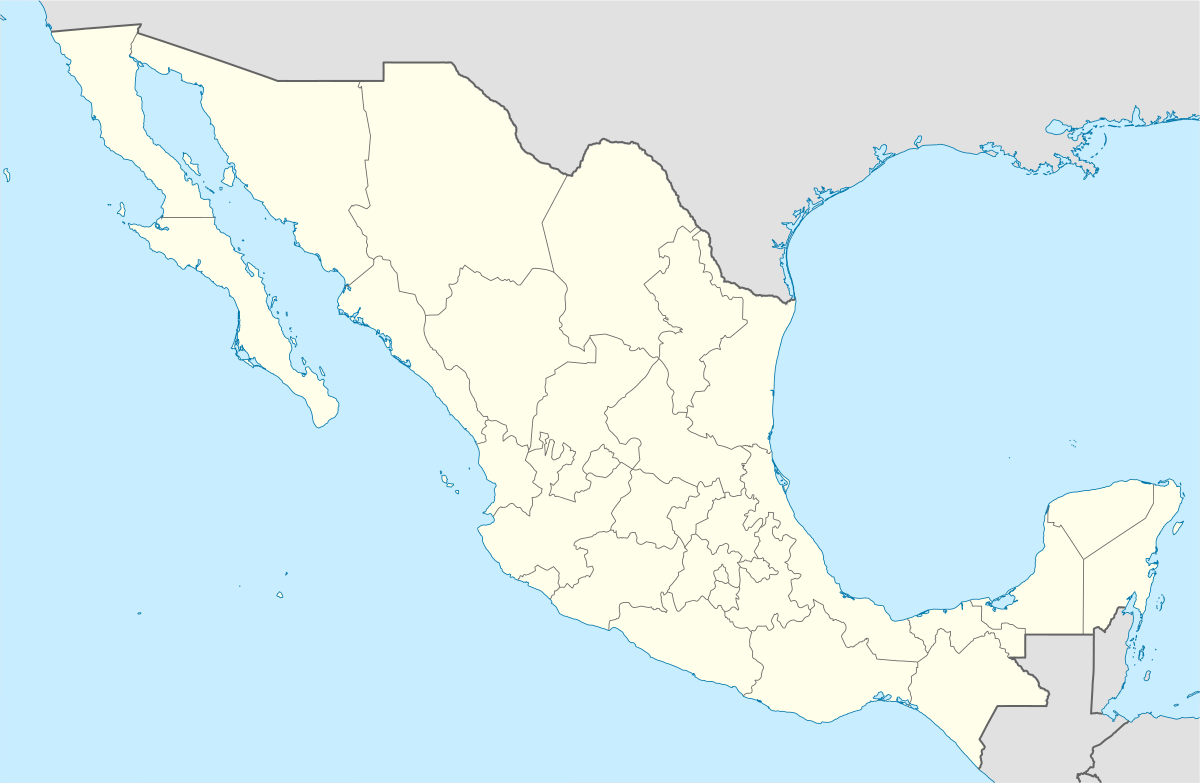Sahagun City
| Sahagun City Ciudad Sahagún | |
|---|---|
| Town and industrial city | |
| Fray Bernardino de Sahagún | |
 Sahagun City in Mexico | |
| Coordinates (Town): 19°46′17″N 98°34′49″W / 19.77139°N 98.58028°WCoordinates: 19°46′17″N 98°34′49″W / 19.77139°N 98.58028°W | |
| Country |
|
| State |
|
| Municipality |
|
| First factories | 1951 |
| Official ignauguration | 1952 |
| Incorporation to municipality of Tepeapulco | 1971 |
| Named for | Bernardino de Sahagún |
| Colognes | 38 |
| GovernmentThe town has no self-government, the highest authority (like all the towns in Mexico) is the mayor of the municipality where, in this case is Tepeapulco. | |
| • Type | Ayuntamiento |
| • Mayor or President of municipality of Tepeapulco |
Alberto Franco ( |
| Elevation | 2,450 m (8,040 ft) |
| Population (2010)[1] | |
| • Total | 28,609 |
| Demonym(s) | Sahagunense |
| Time zone | UTC-06 (Mexico's Central time) |
| • Summer (DST) | UTC-05 (Mexico's DTS) |
| Postal code | 43990 |
| Mexico's Area code | 791 |
| Website |
www |
Sahagun City (in Spanish Ciudad Sahagún), officially called Fray Bernardino de Sahagún; is a little town localized in the municipality of Tepeapulco, within the State of Hidalgo, in Mexico. At its creation it was an important industrial center, but various economic problems have brought Sahagun a point of bankruptcy.[2]
History
Antecedents
In the early 1950s, by order of President Miguel Aleman Valdes, settled on land in the municipality of Tepeapulco, Hidalgo, to 95 kilometers north of Mexico City, what was intended as a national model: the industrial area of Sahagun City.
The firsts factories
On July 28, 1951 "Diesel Nacional" (National Diesel, DINA) was created, with a license agreement and technical advice from the Italian company Fiat. The share capital amounted to 75 million of pesos, of which 78 percent were state participation.
In 1952 he began building the first ship of the National Builder Railway Car (Concarril). At the same time sought to resolve the crisis in the textile and in 1954 formed the National Textile Machinery Factory "Toyoda of Mexico," which later became National Steel (Sidena), which established the three core businesses anchor factory in Sahagún City.
Housing units (colognes)
In parallel, constructed a popular housing group of 1317 houses and 46 apartments, more shops, market, sports fields, administrative offices and basic medical and educational services; as well as introduction of services such as paving, drainage, drinking water, electricity. In 1961 he joined 515 houses built by the IMSS.
Incorpororation to the municipality of Tepeapulco
In 1971 Sahagún City was incorporated into the municipality of Tepeapulco.
Entrance to neoliberalism
After the arrival of different plants, several economic situations (like the arrival of foreign brands into Mexico) forced the Renault plant to close its doors in 1986, losing 7000 jobs.
As Sidena, in state hands, began to have liquidity problems due to the looting of their coffers into the hands of managers, according to a study by the state government. In the late 1980s, Concarril, was taken over by Bombardier, Canadian equity firm and its transformation brought less paternalistic policies affecting unionized workers, who until then enjoyed privileges such as exemption from property taxes and utilities, absorbing the company.
By 1993, National Steel filed for bankruptcy technique due to liquidity problems. Dina, meanwhile, closed in January 2002 the top floor (DINA-Trucks); before was separated from DINA-Buses, acquired by Motor Coach Industries (MCI).
Restart
After 2005 new businesses have arrived to the industrial area of Sahagun City, the product of several government attempts to restore the city economy. Although it's generally considered that while Sahagun may not return to its economic status of the past, at least it ought to be able to keep its economy stable for a while.
Economy
For 2008, Sahagun City housed 3 large companies, 17 medium-sized companies and 40 microenterprises, adding 60 companies and nearly 12,000 jobs, unlike 40.000 work places that had been made for nearly 36 years of tremendous progress. The Svenska Cellulosa Aktiebolaget (SCA), Praxair, Gerdau and The Greenbrier Companies are among companies that have recently arrived.
Bombardier split construction of 204 Flexity Outlook streetcars, for the Toronto Transit Commission, and 182 Flexity Freedom light rail vehicles for service in the Greater Toronto Area between its Sahagun factory, and one of its factories in Thunder Bay, Ontario.[3] Welding the basic chassis was to take place in the Sahagun factory. Bombardier fell years behind in delivery of these vehicles. Reports in the Canadian press repeated claims that the workers in the Thunder Bay plant that the work done in Sahagun was not competently performed. Bombardier tried to speed up construction by opening up an additional production line in its plant in Kingston, Ontario.
References
- ↑ "Instituto Nacional de Estadística y Geografía (INEGI)". www.inegi.org.mx.
- ↑ ""Nostalgia City" documentary".
- ↑
Ben Spurr, Edward Keenan, Marco Chown Oved, Jayme Poisson, Marina Jimenez, David Rider (2017-05-05). "Not in service". Toronto Star. Archived from the original on 2018-07-06. Retrieved 2018-07-06.
Most notably, workers at the Sahagun plant were failing at what one official calls the “black art” of welding.
